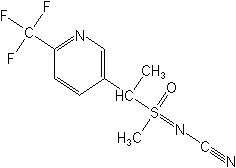• A fluoridated pesticide
• Molecular formula for Sulfoxaflor: C10-H10-F3-N3-O-S

An appeals court Thursday overturned federal approval of an insecticide used on a variety of crops, ruling that it could hasten an already “alarming” decline in bees.
The U.S. 9th Circuit Court of Appeals said the federal Environmental Protection Agency approved the insecticide, sulfoxaflor, based on flawed and limited information. Initial studies showed the insecticide was highly toxic to honey bees.
“Bees are essential to pollinate important crops and in recent years have been dying at alarming rates,” Judge Mary M. Schroeder, a Carter appointee, wrote for a three-judge panel.
Beekeepers and beekeeping organizations challenged the EPA’s 2013 approval of sulfoxaflor, made by Dow Agrosciences and designed for use on many crops, including citrus, cotton, canola, strawberries, soybeans and wheat.
Janette Brimmer, who represented the beekeepers for Earthjustice, an environmental group, said the ruling affects the entire country and will force states to withdraw more local rules that have permitted the insecticide.
Federal appeals courts “almost never” overturn EPA approvals of pesticides, Brimmer said.
“This was a pretty significant decision,” she said. “It revokes the registration, and it is a national registration.”
Sold under the brand names Closer and Transform, sulfoxaflor is an insecticide aimed at piercing and sucking insects (such as aphids and lygus) that attack a variety of crops, such as cotton, tomato, pepper, strawberry and citrus. It was registered for use in California in 2014, according to Department of Pesticide Regulation records.
California regulators have limited the insecticide’s use to lettuce, which does not attract bees. Lettuce growers asked for special permission this year to apply the chemical to control aphids.
The California Department of Pesticide Regulation granted the request but restricted the amount farmers could use. As a result of Thursday’s ruling, the state will prevent sulfoxaflor’s use on any produce, a department spokeswoman said.
The court said the EPA recognized the potential hazard to bees but decided the risks would be reduced by rules limiting applications. That decision was made without “any meaningful study,” the court said.
“Given the precariousness of bee populations, leaving the EPA’s registration of sulfoxaflor in place risks more potential environmental harm than vacating it,” the 9th Circuit concluded.
